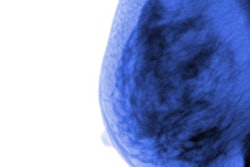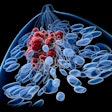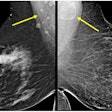High breast density may play an important role in tumor aggressiveness, especially in younger women, according to study results published online in Breast Cancer Research.
Clinical literature on the association between mammographic density and breast cancer has been inconsistent, according to lead author Celine Vachon, PhD, of the Mayo Clinic College of Medicine in Rochester, MN, and colleagues. Some analyses show no clear differences in strength of association by tumor, while others suggest that the association between breast density and cancer risk differs by a woman's estrogen-receptor (ER) status, or by the invasiveness and size of tumors.
To investigate the relationship, the group conducted a study evaluating whether breast density is associated with subtypes of breast tumors, and whether the strength of the association varies by age (Breast Cancer Research, November 4, 2013).
"Because mammographic density is a potential risk factor for [breast cancer] prediction models, understanding whether mammographic density is a risk factor for all breast cancer subtypes, including the most aggressive, and whether these associations are consistent at all ages, is highly significant," Vachon's team wrote.
The group pooled data from six studies that included a total of 3,414 women with breast cancer and 7,199 without the disease who underwent screening mammography. Data came from the following:
- Mayo Mammography Health Study
- Mayo Clinic Breast Cancer Study
- Nurses' Health Study, I and II
- San Francisco Bay Area Breast Cancer SPORE (Specialized Program of Research Excellence)
- San Francisco Mammography Registry
Vachon and colleagues assessed a woman's percentage of breast density from digitized film-screen mammograms using a computer-assisted threshold technique (Cumulus custom mammographic density software developed by the University of Toronto and the University of California, San Francisco).
They also calculated breast cancer odds according to tumor type, histopathological characteristics, and receptor status by age. Receptors included estrogen (ER), progesterone (PR), and human epidermal growth factor (HER2); age categories were younger than 55, 55 to 64, and 65 and older.
Vachon's team found that mammographic density was positively associated with the risk of invasive tumors across all ages; in addition, there was a twofold increased risk for women with high density scores (more than 51%) versus those with average density scores (11% to 25%). Women with 0 to 10% mammographic density had half the risk of breast cancer compared to women with 11% to 25% density. Women younger than 55 with high mammographic density had a higher risk of ductal carcinoma in situ (DCIS) than women age 55 and older.
For younger women, there was a stronger link between mammographic density and ER-negative than ER-positive tumors, compared with women older than 55. Mammographic density was also positively associated with both HER2-negative and HER2-positive tumors within each age group.
The study findings suggest that mammographic density is a risk factor for all subtypes of breast cancer examined, but it's a stronger risk factor for large tumors and node-positive disease among all women, according to Vachon and colleagues.
"Understanding how [mammographic density] is differentially associated with breast cancer subtypes by age, particularly subtypes with poor prognosis more commonly diagnosed in younger women, could lead to novel strategies to reduce breast cancer incidence," they concluded.




















